The global torula yeast market is estimated to be valued at USD 2.6 billion in 2025 and is projected to reach USD 3.7 billion by 2035, registering a compound annual growth rate (CAGR) of 3.7% over the forecast period. An absolute dollar opportunity of approximately USD 1,100 million is anticipated to be added over the decade, reflecting a 1.42-times growth at a compound annual growth rate of 3.7%. The market’s evolution is expected to be shaped by increasing demand for natural flavor enhancers in food and beverage formulations, growing adoption in animal feed for protein enrichment, and rising investment in clean-label ingredients.
By 2030, the market is likely to reach USD 3.1 billion, accounting for USD 500 million in incremental value over the first half of the decade. The remaining USD 600 million is expected during the second half, suggesting a back-loaded growth pattern amid accelerating demand in feed and supplement sectors.
Companies such as Koninklijke DSM, Lallemand, Oriental Yeast, Synergy Flavors, and Chr. Hansen are reinforcing their market positions through expansion of fermentation capacity, investment in processing technologies, and innovation in clean-label formulations. Strategic collaborations and R&D alliances are fuelling product penetration in both food and feed segments, with regulatory compliance and nutritional functionality remaining central to competitive differentiation.
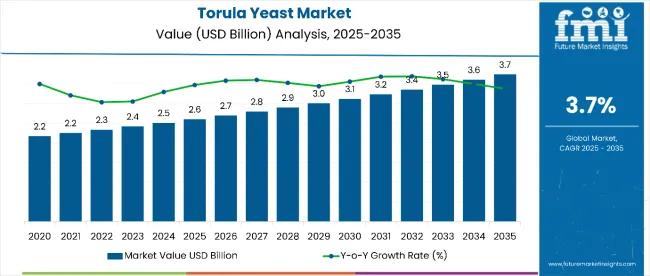
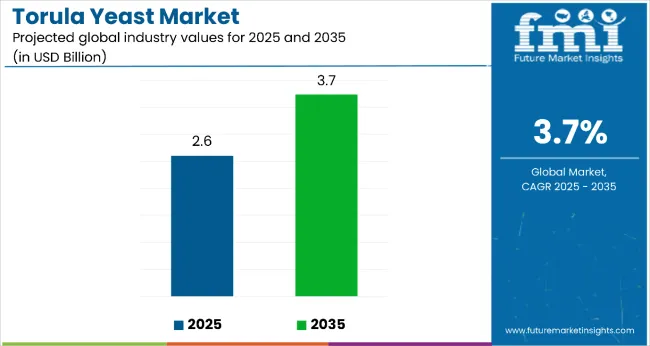
| Metric | Value |
|---|---|
| Estimated Size (2025E) | USD 2.6 billion |
| Projected Value (2035F) | USD 3.7 billion |
| CAGR (2025 to 2035) | 3.7% |
The market holds a significant niche within several broader parent markets. In the food ingredients sector, torula yeast captures approximately 8-10% of the natural flavor enhancer segment, driven by demand for clean-label and plant-based solutions. Within animal feed ingredients, it accounts for around 6-7%, favored for its sustainable protein content and digestibility benefits. In nutritional supplements, torula yeast’s share is smaller but growing, estimated at 3-4%, as awareness of its B-vitamin profile rises. The specialty yeast market includes torula yeast as a key component, representing roughly 12% due to its diverse applications. Overall, torula yeast maintains a steadily expanding presence across these interconnected markets.
Strong momentum is being driven by consumer demand for natural, savory (umami) flavor alternatives, expansion of plant-based and health-focused food portfolios, and increased feed industry uptake for livestock and aquaculture nutrition. Innovation is evidenced by development of encapsulated forms for stability, high-protein blends targeting pet food, and precision fermentation methods reducing process footprint. Regulatory trends favoring clean-label disclosure and upcycled ingredients are reinforcing adoption, while supply chain consolidation and raw material standardization continue to underpin market stability.
Torula yeast’s natural umami profile, high protein content, and clean-label credentials have made it a preferred choice for food manufacturers seeking sustainable flavor enhancement solutions. Its ability to improve taste without synthetic additives aligns strongly with consumer demand for natural and minimally processed ingredients. Additionally, its role as a nutrient-rich feed additive is boosting adoption in the livestock and aquaculture sectors.
Rising awareness of plant-based and allergen-free protein sources is further accelerating uptake, especially in functional foods, vegan products, and specialty nutrition formulations. Technological advances in precision fermentation and upcycling of wood-derived substrates are improving yield efficiency and product consistency, broadening commercial viability. As demand for sustainable, protein-dense, and regulatory-compliant ingredients grows, the torula yeast market is positioned for steady expansion across food, beverage, pet nutrition, and feed industries.
The market is segmented by type, form, application, distribution channel, and region. By type, the market is divided into baker’s yeast, wine yeast, feed yeast, bio-ethanol yeast, nutritional yeast, and deactivated yeast. Based on form, the market is classified into instant yeast, dry yeast, and fresh yeast. By application, the market is segmented into food industry, paper industry, pharmaceutical industry and energy. By distribution channel, the market is divided into store-based retail, specialty stores, online retail, supermarkets, and hypermarkets. Regionally, the market is classified into North America, Eastern Europe, Western Europe, Asia-Pacific, Latin America, and Japan.
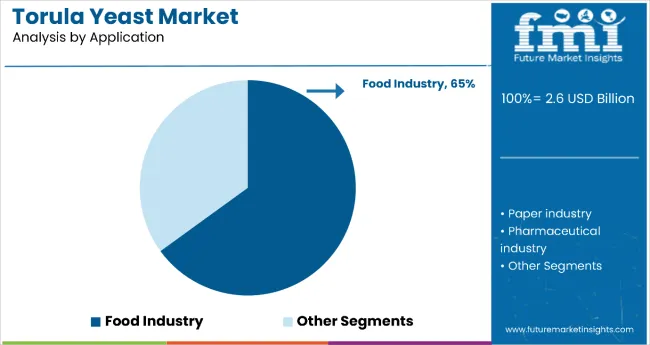
The food industry segment commands a 65% share of the torula yeast market, driven by its role as a natural flavor enhancer and nutritional fortifier. Its savory umami characteristics make it ideal for soups, sauces, ready meals, plant-based meat alternatives, and snack seasonings. The clean-label movement has further amplified its relevance, as manufacturers seek to replace synthetic additives with naturally derived solutions.
Growing consumer interest in healthier, plant-based products is boosting the incorporation of torula yeast in vegan cheese, protein bars, and meat analogs. Its high protein and vitamin content add both nutritional and sensory value, while its allergen-free and non-GMO attributes appeal to diverse dietary preferences. Product innovation, such as low-sodium savory seasonings and encapsulated yeast powders for extended stability, is expected to support this segment’s expansion across mainstream and specialty food sectors.
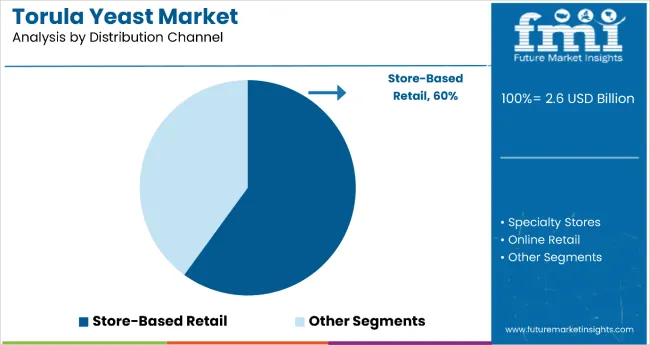
Store-based retail holds a dominant 60% share of the torula yeast market, supported by the accessibility and consumer trust associated with physical purchase points. Supermarkets, hypermarkets, and specialty food stores provide an immediate product experience, enabling customers to evaluate freshness, packaging quality, and labeling before purchase. This tactile engagement remains a critical driver in consumer decision-making for specialty food ingredients.
The segment benefits from strategic product placements, in-store promotions, and sampling programs that build brand familiarity and encourage trial. Specialty retailers often showcase torula yeast alongside other premium, plant-based ingredients, reinforcing its positioning as a healthy and sustainable option. As demand for natural and functional food products rises, store-based channels are increasingly partnering with niche and emerging brands to diversify offerings. Despite the growth of e-commerce, store-based retail is projected to retain a stronghold, particularly in regions where consumers prioritize physical inspection and immediate product access.
In 2024, global torula yeast market consumption increased by 12% year-on-year, with North America and Europe together accounting for over 55% of demand. Applications span natural flavor enhancement, protein enrichment, and functional ingredient formulation across food, beverage, feed, and dietary supplements. Manufacturers are leveraging precision fermentation, advanced drying methods, and substrate optimization to improve yield efficiency and sensory consistency. Clean-label product positioning and sustainable sourcing are becoming central to competitive differentiation. Rising consumer demand for plant-based proteins, coupled with the shift away from artificial additives, continues to reinforce the market’s adoption trajectory across diverse end-use industries.
Plant-Based Nutrition and Clean-Label Trends Drive Torula Yeast Adoption
Food and beverage producers are increasingly incorporating torula yeast to deliver natural umami flavor, protein fortification, and B-vitamin enrichment without synthetic additives. Its allergen-free, non-GMO profile aligns well with consumer health priorities, while its adaptability in meat alternatives, vegan cheeses, and savory snacks is expanding application diversity. In feed and pet nutrition, torula yeast serves as a sustainable protein source with proven digestibility benefits, contributing to reduced reliance on conventional soy or fishmeal inputs. These nutritional and environmental advantages drive adoption rates upward, particularly in premium and specialty product segments.
Price Sensitivity, Supply Chain Limitations, and Technical Processing Restrain Growth
Market expansion faces constraints from feedstock cost volatility, specialized fermentation infrastructure requirements, and the limited number of commercial-scale processing facilities. Seasonal fluctuations in wood-derived feedstock availability can impact raw material costs by up to 15%, while precision fermentation processes add both capital expenditure and operational complexity. Cold storage and moisture-controlled logistics elevate distribution costs compared to conventional protein additives. These factors, combined with the need for technical expertise in flavor optimization, present barriers for small- and mid-scale producers in price-sensitive markets.
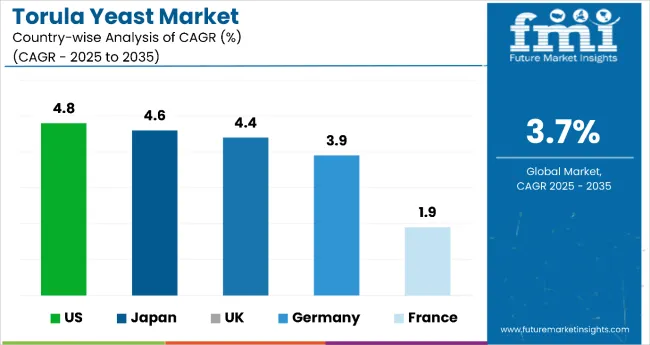
| Country | CAGR (2025 to 2035) |
|---|---|
| USA | 4.8% |
| Japan | 4.6% |
| UK | 4.4% |
| Germany | 3.9% |
| France | 1.9% |
In the torula yeast market, the USA is forecasted to lead with a CAGR of 4.8% between 2025 and 2035, driven by strong demand in natural flavor enhancers and plant-based protein segments. Japan follows at 4.6%, supported by innovation in functional food applications and precision fermentation techniques. The UK ranks third at 4.4%, with growth concentrated in vegan and clean-label product categories. Germany’s CAGR of 3.9% reflects steady uptake in sustainable feed applications and specialty savory seasonings, while France shows the slowest growth at 1.9%, constrained by limited production expansion and slower consumer adoption outside premium segments.
The report covers an in-depth analysis of 40+ countries; five top-performing OECD countries are highlighted below.
Revenue from torula yeast in the USA is estimated to increase at a CAGR of 4.8% from 2025 to 2035, surpassing the global average. Growth is driven by demand for sustainable protein sources and natural umami flavoring in processed foods, snacks, and plant-based meats. Key markets in California, Illinois, and New York are seeing rapid adoption in premium food manufacturing, while livestock and aquaculture feed sectors are expanding usage for nutritional enrichment. Investment in large-scale fermentation facilities and advancements in spray-drying technology are enhancing both production capacity and ingredient functionality.
Key Statistics:
Demand for torula yeast in Japan is anticipated to expand at a CAGR of 4.6% from 2025 to 2035, fueled by precision fermentation advancements and strong demand for natural seasonings in traditional and fusion cuisines. High adoption is seen in Tokyo, Osaka, and Nagoya, where consumer preference leans toward premium, clean-label products. Applications in instant noodles, snack seasonings, and plant-based meat analogs are gaining momentum. Japanese manufacturers are focusing on quality improvements, allergen-free certifications, and moisture-stable formulations to cater to both domestic and export markets.
Key Statistics:
Revenue from torula yeast in the UK is expected to rise at a CAGR of 4.4% from 2025 to 2035, supported by expanding vegan and flexitarian diets. Major demand centers include London, Manchester, and Birmingham, with growing applications in meat-free ready meals, sauces, and baked goods. Partnerships between ingredient suppliers and plant-based food manufacturers are accelerating innovation. Post-Brexit trade shifts have prompted increased investment in domestic yeast production to reduce import dependency, though production scalability remains a challenge.
Key Statistics:
Sales of torula yeast in Germany are projected to flourish at a CAGR of 3.9% from 2025 to 2035, driven by adoption in sustainable feed protein and savory seasonings. Key urban centers such as Hamburg, Munich, and Berlin are leading consumption due to strong demand for premium and functional food products. Collaborations between German biotech firms and European ingredient companies are supporting technological innovation and application diversification. The regulatory emphasis on clean-label compliance is also boosting the appeal of torula yeast in both food and feed industries.
Key Statistics:
The torula yeast market in France is forecasted to grow at a moderate CAGR of 1.9% from 2025 to 2035, below the global average. Growth is primarily concentrated in premium culinary applications such as gourmet sauces, artisanal soups, and specialty snack seasonings. Paris, Lyon, and Marseille remain the leading demand hubs. Limited domestic fermentation infrastructure and reliance on imports restrain faster market penetration, but partnerships with high-end food manufacturers are supporting niche adoption.
Key Statistics:
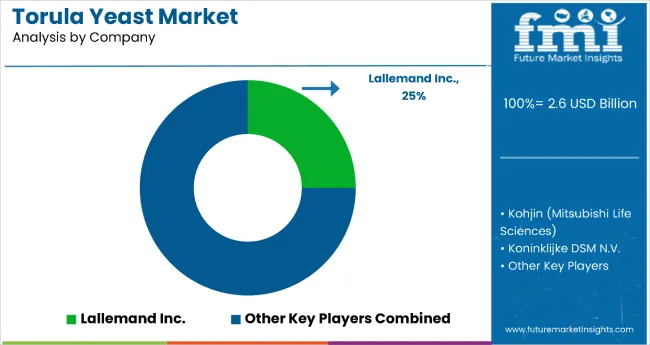
The torula yeast market is marked by moderate consolidation, with a mix of multinational ingredient giants, yeast-specialized firms, and regional players offering diverse technological capabilities, production scales, and application expertise. Leading companies such as Lallemand Inc., Koninklijke DSM N.V., Oriental Yeast Co., Ltd., Synergy Flavors, and Chr. Hansen are well-recognized for their fermentation proficiency and extensive functional ingredient portfolios. Additional formidable competitors include Kanegrade Ltd., Mitsubishi Corporation Life Sciences Holdings, Associated British Foods (ABF) plc, Angel Yeast, and Lesaffre Group, each contributing unique strengths in production, formulation, or regional access.
Innovation-driven differentiation is being pursued by several firms. Lallemand Inc. and Koninklijke DSM are investing in strain development and clean-label yeast variants tailored for savory, plant-based applications. Oriental Yeast emphasizes customization for specialty uses in Asian culinary and fermentation markets. Synergy Flavors focuses on sensory expertise, elevating torula yeast as an ingredient-driven flavor technology. Regional specialists such as Lesaffre are advancing sustainable, waste-derived fermentation approaches to support bio-based and organic applications. Such strategic focuses are enabling penetration into value-added segments like pet foods, nutraceuticals, and clean-label processed products.
Notably, entry into the torula yeast space remains challenging due to high capital requirements associated with advanced fermentation and spray-drying infrastructure, plus rigorous safety and regulatory compliance standards. The presence of viable substitutes, such as yeast extracts, MSG, and plant-based savory ingredients, further elevates competitive pressures. Success in this market is increasingly tied to production efficiency, strain innovation, clean-label positioning, and the ability to tailor offerings across food, feed, and nutraceutical sectors.
| Item | Value |
|---|---|
| Quantitative Units | USD 2.6 Billion |
| Type | Baker’s Yeast, Wine Yeast, Feed Yeast, Bio-Ethanol Yeast, Nutritional Yeast, Deactivated Yeast |
| Form | Instant Yeast, Dry Yeast, Fresh Yeast |
| Application | Food Industry, Paper Industry, Pharmaceutical Industry, Energy |
| Distribution Channel | Store-Based Retail, Specialty Stores, Online Retail, Supermarkets, Hypermarkets |
| Regions Covered | North America, Eastern Europe, Western Europe, Asia-Pacific, Latin America, Japan, Middle East & Africa |
| Countries Covered | United States, Canada, United Kingdom, Germany, France, China, Japan, South Korea, Brazil, Australia and 40+ countries |
| Key Companies Profiled | Gluthatheon, Koninklijke DSM N.V., Chr. Hansen Holding A/S, Lallemand Inc., Kanegrade, Oriental Yeast Co., Kohjin, Synergy Flavors |
| Additional Attributes | Dollar sales by application and purity grade, regional demand trends, competitive landscape, consumer preferences for natural versus synthetic alternatives, Integration with environmentally responsible sourcing practices, innovations in extraction technology and quality standardization for diverse industrial applications |
The global torula yeast market is estimated to be valued at USD 2.6 billion in 2025.
The torula yeast market size is projected to reach USD 3.7 billion by 2035.
The torula yeast market is expected to grow at a 3.7% CAGR between 2025 and 2035.
The food industry segment is projected to lead in the torula yeast market with 65% market share in 2025.
In terms of distribution channel, store-based retail is expected to command 60% share in the torula yeast market in 2025.






Our Research Products

The "Full Research Suite" delivers actionable market intel, deep dives on markets or technologies, so clients act faster, cut risk, and unlock growth.

The Leaderboard benchmarks and ranks top vendors, classifying them as Established Leaders, Leading Challengers, or Disruptors & Challengers.

Locates where complements amplify value and substitutes erode it, forecasting net impact by horizon

We deliver granular, decision-grade intel: market sizing, 5-year forecasts, pricing, adoption, usage, revenue, and operational KPIs—plus competitor tracking, regulation, and value chains—across 60 countries broadly.

Spot the shifts before they hit your P&L. We track inflection points, adoption curves, pricing moves, and ecosystem plays to show where demand is heading, why it is changing, and what to do next across high-growth markets and disruptive tech

Real-time reads of user behavior. We track shifting priorities, perceptions of today’s and next-gen services, and provider experience, then pace how fast tech moves from trial to adoption, blending buyer, consumer, and channel inputs with social signals (#WhySwitch, #UX).

Partner with our analyst team to build a custom report designed around your business priorities. From analysing market trends to assessing competitors or crafting bespoke datasets, we tailor insights to your needs.
Supplier Intelligence
Discovery & Profiling
Capacity & Footprint
Performance & Risk
Compliance & Governance
Commercial Readiness
Who Supplies Whom
Scorecards & Shortlists
Playbooks & Docs
Category Intelligence
Definition & Scope
Demand & Use Cases
Cost Drivers
Market Structure
Supply Chain Map
Trade & Policy
Operating Norms
Deliverables
Buyer Intelligence
Account Basics
Spend & Scope
Procurement Model
Vendor Requirements
Terms & Policies
Entry Strategy
Pain Points & Triggers
Outputs
Pricing Analysis
Benchmarks
Trends
Should-Cost
Indexation
Landed Cost
Commercial Terms
Deliverables
Brand Analysis
Positioning & Value Prop
Share & Presence
Customer Evidence
Go-to-Market
Digital & Reputation
Compliance & Trust
KPIs & Gaps
Outputs
Full Research Suite comprises of:
Market outlook & trends analysis
Interviews & case studies
Strategic recommendations
Vendor profiles & capabilities analysis
5-year forecasts
8 regions and 60+ country-level data splits
Market segment data splits
12 months of continuous data updates
DELIVERED AS:
PDF EXCEL ONLINE
Yeast Beta Glucan Market Size and Share Forecast Outlook 2025 to 2035
Yeast Based Aqua Protein Market Size and Share Forecast Outlook 2025 to 2035
Yeast Market Outlook - Size, Demand & Forecast 2025 to 2035
Yeast-based Spreads Market Size and Share Forecast Outlook 2025 to 2035
Yeast Extract Market Analysis - Size, Share, and Forecast Outlook 2025 to 2035
Yeast-derived Collagen Market Analysis – Size, Share, and Forecast Outlook 2025 to 2035
Yeast Extract Industry Analysis in USA Size, Growth, and Forecast for 2025 to 2035
Understanding Yeast Extract Market Share & Key Players
Yeastless Dough Market Growth - Innovations & Consumer Preferences 2025 to 2035
Yeast Infection Diagnostics Market Report - Demand, Trends & Industry Forecast 2025 to 2035
Yeast Nucleotides Market Analysis by Product Type, Nature, Form and Application Through 2035
Yeast Infection Treatment Market by Drug Type, Distribution Channel, End User, and Region, 2025 to 2035
Yeast Autolysates Market Outlook - Growth, Demand & Forecast 2024 to 2034
Yeast Flakes Market
UK Yeast Extract Market Report – Trends, Demand & Industry Forecast 2025–2035
Dry Yeast Market Report - Size, Demand & Forecast 2025 to 2035
GCC Yeast Market Trends – Growth, Demand & Forecast 2025–2035
USA Yeast Market Analysis – Size, Share & Forecast 2025-2035
ASEAN Yeast Market Report – Trends, Demand & Industry Forecast 2025–2035
Japan Yeast Market Insights – Demand, Size & Industry Trends 2025–2035

Thank you!
You will receive an email from our Business Development Manager. Please be sure to check your SPAM/JUNK folder too.
Chat With
MaRIA